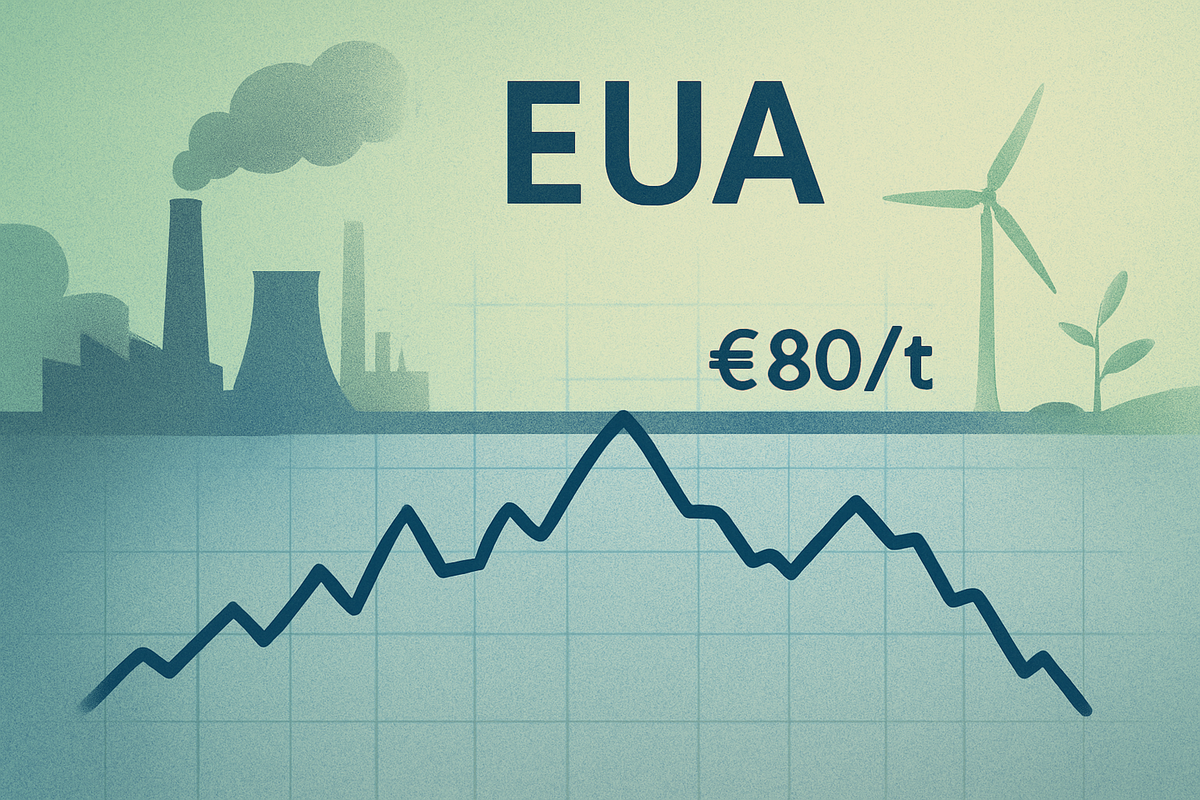
Brussels, Belgium – October 24, 2025 – The European Union Allowances (EUAs) market has experienced a notable cooling trend this week, with carbon prices failing to consistently break through the psychologically and technically significant €80 per tonne (€/t) threshold over the past fortnight. This retreat follows earlier attempts in October to push beyond this mark, indicating a period of consolidation and reassessment within the bloc's flagship climate policy instrument. The immediate implication is a temporary reprieve for high-emitting industries, but it also raises questions about the short-term strength of the carbon price signal crucial for driving green investments.
The current price action reflects a complex interplay of macroeconomic headwinds, temporary supply increases, and evolving industrial demand. While the long-term trajectory for EUAs remains firmly bullish due to stringent policy reforms, the immediate inability to sustain prices above €80/t suggests market participants are navigating a delicate balance between present economic realities and future decarbonization imperatives.
Detailed Coverage: The €80/t Hurdle and Market Dynamics
In the weeks leading up to October 24, 2025, EUA prices (December 2025 contract) exhibited fluctuating movements. After trading in a narrow €71-€73/t range in August, prices saw a 5.3% rise in the first half of September, pushing them above €77/t. This bullish sentiment was bolstered by the maritime sector's initial compliance obligations under the EU ETS, requiring the surrender of 40% of its 2024 emissions. By early October, prices briefly exceeded €79/t, reaching a seven-month high, and on October 10, they fluctuated around the €80/t mark.
However, a key turning point occurred around mid-October, when EUA futures tested the €80/t level, with a brief surge to €80.11, only to be met with strong selling pressure that quickly pushed the price back to approximately €78.00. This indicated a clear failure to sustain a break above this crucial resistance. By October 14, the price had fallen to €76.9/t. The cooling trend continued, with EU Carbon Permits drifting lower on October 21 after bullish traders failed to overcome key resistance, largely ignoring a strong natural gas market. On October 23, prices stood at €78.44, down slightly from the previous day. Despite this recent cooling, EUAs were up 0.7% for the week ending October 14, closing at €79.68, generally trading within a higher trend channel of €74-€80.00.
Key players in the EU ETS market include compliance entities such as major industrial installations and power generators across EU member states, alongside the recently included maritime and aviation sectors. Financial market participants, including investment firms, credit institutions, and funds, provide crucial liquidity and risk management. Regulators like the European Commission and EU Member States set the cap and rules, while analysts (e.g., ICIS, Energy Aspects, Veyt) offer market insights. Environmental groups such as the European Environmental Bureau (EEB) and Carbon Market Watch (CMW) advocate for stronger climate action.
Initial market reactions to the failure to break €80/t have been varied. While some speculative positions were liquidated amidst macroeconomic turbulence, many traders are still accumulating net long positions, betting on future price growth driven by anticipated quota shortages. Analysts largely remain bullish on the long-term outlook, with many forecasting prices to exceed €100/t by 2027. However, the persistent high carbon prices, even with the recent cooling, continue to spur concerns among EU governments, particularly regarding the incoming ETS2 for heating and transport fuels, leading to proposals for mitigating price volatility.
Corporate Landscape: Winners and Losers in a Cooling Market
The recent cooling of EUA prices presents a nuanced picture for public companies across Europe, offering short-term relief to some while potentially dampening the immediate decarbonization incentive for others.
Potential Winners:
- Fossil Fuel Power Generators: Utilities heavily reliant on gas-fired power generation, such as RWE AG (FWB: RWE) or Uniper SE (FWB: UN01), could see reduced operational costs. Lower EUA prices make gas more competitive against coal, improving profit margins.
- Heavy Industry (Net Emitters): Companies in carbon-intensive sectors like steel, cement, and chemicals, including ArcelorMittal SA (AMS: MT), Heidelberg Materials AG (FWB: HEI), and BASF SE (FWB: BAS), that are net buyers of EUAs or still benefit from free allowance allocations, will experience reduced compliance costs in the short term. This offers a reprieve, making their current carbon-intensive production methods less costly.
- Airlines and Shipping Companies: As sectors recently included in the EU ETS, airlines like Lufthansa AG (FWB: LHA) and shipping giants such as A.P. Møller – Mærsk A/S (CPH: MAERSK B) will find their compliance costs lowered by cheaper EUAs, directly improving operational profitability. This also applies to logistics and supply chain operators anticipating the expansion of ETS2 to road transport.
Potential Losers:
- Renewable Energy Producers: While the long-term growth of renewables is robust, a sustained period of lower EUA prices could marginally reduce the immediate financial incentive for utilities to switch from fossil fuels to renewables. This might temporarily slow down investment decisions or make renewable projects marginally less attractive compared to carbon-intensive alternatives. Companies like Ørsted A/S (CPH: ORSTED) or Iberdrola SA (BME: IBE) could see a slight erosion of their competitive advantage if carbon costs for fossil fuels are lower.
- Decarbonization First Movers: Companies that have already invested heavily in costly low-carbon production processes, such as Thyssenkrupp AG (FWB: TKA) in green steel, might see their competitive advantage temporarily eroded if their less green competitors face lower carbon costs. Their higher upfront investments might become less immediately profitable.
- Companies reliant on selling surplus allowances: Firms that have successfully reduced emissions below their free allocation and sell the surplus will see less revenue from these sales due to lower EUA prices.
The cooling of EUA prices, if prolonged, might delay crucial investment decisions in breakthrough decarbonization technologies for some companies. However, the overarching EU climate goals, the impending full implementation of CBAM, and the long-term trend of increasing carbon prices mean that neglecting decarbonization strategies would be a significant long-term risk for sustained competitiveness.
Wider Significance: A Pause in the Carbon Price Ascent
The inability of EUA prices to consistently surpass €80/t in October 2025 is more than a mere market fluctuation; it signifies a pivotal moment for the EU ETS within the broader context of European climate policy and economic trends.
This price cooling occurs amidst ongoing weakness in European manufacturing, which, despite showing some signs of easing, continues to depress overall economic growth and industrial demand for allowances. Geopolitical uncertainties, particularly concerning gas prices and potential trade tariffs, further contribute to market volatility. While the energy sector has significantly decarbonized, heavy industry is increasingly becoming the primary demand driver for allowances. However, with the full implementation of the Carbon Border Adjustment Mechanism (CBAM) and stricter emissions caps from 2026, the market is bracing for structural scarcity.
The ripple effects are notable. For European industries, a temporary plateau in EUA prices offers a short-term respite from rising operational costs. However, the long-term trend of declining free allocations means they still face increasing carbon price exposure. For competitors outside the EU, the current price cooling, if sustained, could slightly lessen the initial financial burden of CBAM on non-EU exporters, though the mechanism's long-term goal of preventing carbon leakage remains. Financial investors, meanwhile, are viewing 2025 as a "transition year" to build long positions in anticipation of significant future price increases.
From a regulatory perspective, the current price dynamics highlight the EU's delicate balancing act. The Market Stability Reserve (MSR), designed to manage allowance supply, will be reviewed in 2026, and its effectiveness is crucial. The proactive price stability measures introduced for the new ETS2, such as doubling allowance releases if prices exceed €45/t, demonstrate regulatory sensitivity to the impact of carbon costs on citizens. The EU's impending 2040 climate target (a 90% emissions reduction by 2040) and the Clean Industry Deal will reinforce the need for a robust carbon price signal, potentially prompting further debate on allowance caps if prices remain subdued.
Historically, the EU ETS has seen periods of low prices, notably during the 2007-2008 financial crisis when an oversupply of allowances accumulated. More recently, prices oscillated around €80/t between 2021 and 2023 before declining towards the end of 2023 due to decreased industrial activity and mild winters. The current cooling below €80/t in 2025 echoes these periods where macroeconomic factors can temporarily override the long-term structural tightening signals. However, analysts largely consider 2025 a "transitional year" before a renewed upward trajectory in EUA prices, driven by fundamental policy changes.
What Comes Next: A Bullish Horizon Beyond Short-Term Headwinds
The short-term outlook for EUA prices (October 2025 - H1 2026) suggests continued volatility, influenced by geopolitical developments, natural gas price fluctuations, and the pace of European economic recovery. However, several factors point towards a modest price recovery, potentially pushing EUAs back into the mid-€70s to low-€80s. Increased demand from the maritime sector, which must surrender 70% of its 2025 emissions by September 2026, and reduced free allocations for aviation (50% in 2025) will contribute to this. Furthermore, the Market Stability Reserve (MSR) will reduce auction volumes by 276 million allowances between September 2025 and August 2026, and the conclusion of REPowerEU allowance sales in 2026 will further tighten supply.
The long-term outlook (2026 and beyond) is overwhelmingly bullish. The "Fit for 55" package significantly tightens the EU ETS by accelerating the Linear Reduction Factor (LRF) to 4.3% annually until 2027 and 4.4% from 2028, ensuring long-term scarcity. The gradual phase-out of free allowances and the full implementation of CBAM from 2026 will significantly increase compliance demand. The expansion of the EU ETS to cover 100% of maritime and aviation emissions from 2026, and the launch of the new ETS2 for road transport and buildings around 2027, will further broaden the demand base. Most analysts forecast EUA prices to average €90-€110/t in 2026 and exceed €100/t by 2027, with some projections reaching €160/t by 2027 and potentially €200/t by 2033.
Strategic pivots will be crucial for market participants. Industrial emitters and power generators must engage in proactive hedging strategies and accelerate investments in decarbonization technologies to mitigate rising carbon costs. Financial investors are likely to continue building long positions, anticipating future scarcity, while navigating short-term volatility. New trading opportunities will emerge from the expanded sectoral coverage and increased market complexity.
Challenges include continued price volatility due to external shocks, regulatory uncertainty surrounding ongoing reviews (e.g., MSR in 2026), and the potential for increased compliance costs to impact the competitiveness of EU businesses. However, opportunities abound in investments in low-carbon assets, carbon project development, and strategic partnerships for abatement.
Potential scenarios include a Bullish Scenario, driven by strong economic recovery and rigorous "Fit for 55" implementation, pushing prices well above €100/t. A Bearish Scenario could see prices stagnate in the €60-€75/t range if economic weakness persists or policies are delayed. A Volatile Scenario, a continuation of the current trend, would see prices oscillate but with an underlying long-term upward trajectory.
Wrap-up: Navigating the Inevitable Rise of Carbon Costs
The recent cooling of EU Allowances prices, marked by their struggle to consistently breach the €80/t threshold, serves as a significant, albeit temporary, market adjustment. It underscores the sensitivity of the EU ETS to immediate macroeconomic conditions and energy market dynamics. While this period offers a brief respite for some high-emitting industries, it should not be misinterpreted as a fundamental weakening of Europe's climate ambition or the long-term trajectory of carbon costs.
The market moving forward, particularly from 2026, is poised for a structural tightening driven by the "Fit for 55" legislative package. This includes accelerated emissions cap reductions, the complete phase-out of free allowances, the full implementation of the Carbon Border Adjustment Mechanism (CBAM), and the expansion of the EU ETS to new sectors like maritime and, eventually, road transport and buildings (ETS2). These reforms are designed to create a sustained and robust carbon price signal, making the €80/t mark that proved so challenging in 2025 a likely floor, rather than a ceiling, for future prices.
The lasting impact of this event will be the reinforcement of the EU ETS as a powerful driver for decarbonization. Companies across Europe will face increasing pressure to invest in low-carbon technologies and abatement measures, as the cost of emitting carbon is projected to rise considerably. The current pause is merely a moment for strategic recalibration before the market enters a period of heightened scarcity and higher prices.
Investors in the coming months should closely monitor several key factors:
- Policy Implementation: Watch for the outcomes of the full CBAM review (early 2026), the EU ETS and MSR review in 2026, and any final adjustments to the ETS2 rollout.
- Supply and Demand Fundamentals: Track the completion of REPowerEU allowance sales, the increasing compliance obligations from the maritime and aviation sectors, and industrial output data.
- Macroeconomic and Geopolitical Trends: Continue to assess the health of the European economy, energy prices, and geopolitical developments, as these will continue to influence short-term volatility.
- Political Landscape: While the long-term direction is set, any shifts in the "green political agenda" post-2024 EU Parliament elections, particularly concerning post-2030 climate targets or the inclusion of carbon removal credits, could introduce new dynamics.
In essence, while the EU carbon market has taken a breath around the €80/t level, the underlying forces are pushing it towards a fundamentally tighter and more expensive future. Savvy investors and businesses will use this period to prepare for the inevitable ascent of carbon costs and the profound transformation of the European industrial landscape.
This content is intended for informational purposes only and is not financial advice





